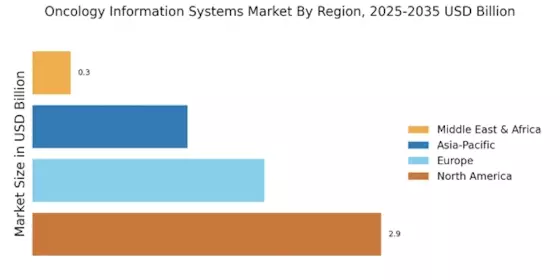Rising Cancer Incidence
The increasing prevalence of cancer worldwide is a primary driver for the Oncology Information Systems Market. According to recent statistics, cancer cases are projected to rise significantly, with estimates suggesting that by 2040, the number of new cancer cases could reach 27.5 million annually. This alarming trend necessitates advanced information systems to manage patient data, treatment plans, and outcomes effectively. As healthcare providers seek to enhance their capabilities in oncology care, the demand for sophisticated information systems that can streamline processes and improve patient management is likely to grow. Consequently, the Oncology Information Systems Market is expected to expand as healthcare organizations invest in technology to address the rising burden of cancer.
Technological Advancements
Technological innovations play a crucial role in shaping the Oncology Information Systems Market. The integration of advanced technologies such as machine learning, big data analytics, and cloud computing is transforming how oncology information systems operate. These advancements enable healthcare providers to analyze vast amounts of data, leading to improved treatment protocols and personalized medicine. For instance, the market for oncology information systems is anticipated to witness a compound annual growth rate of approximately 10% over the next few years, driven by the need for more efficient data management solutions. As technology continues to evolve, the Oncology Information Systems Market is likely to see increased adoption of these cutting-edge tools, enhancing the overall quality of cancer care.
Increased Focus on Data Security
Data security has become a paramount concern in the healthcare sector, particularly within the Oncology Information Systems Market. With the rise in cyber threats and data breaches, healthcare organizations are prioritizing the protection of sensitive patient information. Regulatory frameworks, such as the Health Insurance Portability and Accountability Act (HIPAA), mandate stringent data security measures, driving the need for robust oncology information systems that comply with these regulations. As organizations invest in secure systems to safeguard patient data, the Oncology Information Systems Market is likely to experience growth. This focus on data security not only protects patients but also enhances the credibility of healthcare providers, fostering trust in oncology care.
Emphasis on Personalized Medicine
The trend towards personalized medicine is significantly influencing the Oncology Information Systems Market. As research advances, there is a growing recognition that cancer treatment should be tailored to individual patient profiles, including genetic and molecular characteristics. This shift necessitates sophisticated information systems capable of integrating diverse data sources to support personalized treatment plans. The Oncology Information Systems Market is poised for growth as healthcare providers seek systems that can facilitate this level of customization. By leveraging data analytics and patient information, oncology information systems can enhance treatment efficacy and improve patient outcomes, aligning with the broader movement towards personalized healthcare.
Growing Demand for Telehealth Solutions
The shift towards telehealth solutions has emerged as a significant driver for the Oncology Information Systems Market. As healthcare systems adapt to changing patient needs, the demand for remote monitoring and virtual consultations has surged. This trend is particularly relevant in oncology, where patients often require ongoing support and follow-up care. The Oncology Information Systems Market is responding to this demand by developing systems that facilitate telehealth capabilities, allowing for seamless communication between patients and healthcare providers. The market is expected to grow as more organizations recognize the importance of integrating telehealth features into their oncology information systems, ultimately improving patient access to care and treatment adherence.


















Leave a Comment